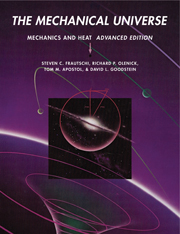Book contents
- Frontmatter
- Contents
- Preface
- Chapter 1 INTRODUCTION TO THE MECHANICAL UNIVERSE (Program 1)
- Chapter 2 THE LAW OF FALLING BODIES (Program 2)
- Chapter 3 THE LANGUAGE OF NATURE: DERIVATIVES AND INTEGRALS
- Chapter 4 INERTIA
- Chapter 5 VECTORS
- Chapter 6 NEWTON'S LAWS AND EQUILIBRIUM
- Chapter 7 UNIVERSAL GRAVITATION AND CIRCULAR MOTION
- Chapter 8 FORCES
- Chapter 9 FORCES IN ACCELERATING REFERENCE FRAMES
- Chapter 10 ENERGY: CONSERVATION AND CONVERSION
- Chapter 11 THE CONSERVATION OF MOMENTUM
- Chapter 12 OSCILLATORY MOTION
- Chapter 13 ANGULAR MOMENTUM
- Chapter 14 ROTATIONAL DYNAMICS FOR RIGID BODIES
- Chapter 15 GYROSCOPES
- Chapter 16 KEPLER'S LAWS AND THE CONIC SECTIONS
- Chapter 17 SOLVING THE KEPLER PROBLEM
- Chapter 18 NAVIGATING IN SPACE
- Chapter 19 TEMPERATURE AND THE GAS LAWS
- Chapter 20 THE ENGINE OF NATURE
- Chapter 21 ENTROPY
- Chapter 22 THE QUEST FOR LOW TEMPERATURE
- Appendix A THE INTERNATIONAL SYSTEM OF UNITS
- Appendix B CONVERSION FACTORS
- Appendix C FORMULAS FROM ALGEBRA, GEOMETRY, AND TRIGONOMETRY
- Appendix D ASTRONOMICAL DATA
- Appendix E PHYSICAL CONSTANTS
- SELECTED BIBLIOGRAPHY
- Index
Chapter 6 - NEWTON'S LAWS AND EQUILIBRIUM
Published online by Cambridge University Press: 05 August 2013
- Frontmatter
- Contents
- Preface
- Chapter 1 INTRODUCTION TO THE MECHANICAL UNIVERSE (Program 1)
- Chapter 2 THE LAW OF FALLING BODIES (Program 2)
- Chapter 3 THE LANGUAGE OF NATURE: DERIVATIVES AND INTEGRALS
- Chapter 4 INERTIA
- Chapter 5 VECTORS
- Chapter 6 NEWTON'S LAWS AND EQUILIBRIUM
- Chapter 7 UNIVERSAL GRAVITATION AND CIRCULAR MOTION
- Chapter 8 FORCES
- Chapter 9 FORCES IN ACCELERATING REFERENCE FRAMES
- Chapter 10 ENERGY: CONSERVATION AND CONVERSION
- Chapter 11 THE CONSERVATION OF MOMENTUM
- Chapter 12 OSCILLATORY MOTION
- Chapter 13 ANGULAR MOMENTUM
- Chapter 14 ROTATIONAL DYNAMICS FOR RIGID BODIES
- Chapter 15 GYROSCOPES
- Chapter 16 KEPLER'S LAWS AND THE CONIC SECTIONS
- Chapter 17 SOLVING THE KEPLER PROBLEM
- Chapter 18 NAVIGATING IN SPACE
- Chapter 19 TEMPERATURE AND THE GAS LAWS
- Chapter 20 THE ENGINE OF NATURE
- Chapter 21 ENTROPY
- Chapter 22 THE QUEST FOR LOW TEMPERATURE
- Appendix A THE INTERNATIONAL SYSTEM OF UNITS
- Appendix B CONVERSION FACTORS
- Appendix C FORMULAS FROM ALGEBRA, GEOMETRY, AND TRIGONOMETRY
- Appendix D ASTRONOMICAL DATA
- Appendix E PHYSICAL CONSTANTS
- SELECTED BIBLIOGRAPHY
- Index
Summary
Then from these forces, by other propositions which are also mathematical, I deduce the motions of the planets, the comets, the moon, and the sea. I wish we could derive the rest of the phenomena of Nature by the same kind of reasoning from mechanical principles, for I am induced by many reasons to suspect that they may all depend upon certain forces by which the particles of bodies, by some cause hitherto unknown, are either mutually impelled towards one another, and cohere in regular figures, or are repelled and recede from one another. These forces being unknown, philosophers have hitherto attempted the search of nature in vain; but I hope the principles here laid down will afford some light either to this or some truer method of philosophy.
Isaac Newton, Principia (1686)THE END OF THE CONFUSION
In 1543 Copernicus published his book, and a tremor rocked the foundations of the Aristotelian world. A century later the Aristotelian world lay in ruins, but nothing had risen to replace it. Galileo and Kepler had made mighty discoveries, but there was no central principle that could organize the world. The unified harmony of the Aristotelian view had been replaced by buzzing confusion.
Galileo was concerned not with the causes of motion but instead with its description. The branch of mechanics he reared is known as kinematics; it is a mathematically descriptive account of motion without concern for its causes.
- Type
- Chapter
- Information
- The Mechanical UniverseMechanics and Heat, Advanced Edition, pp. 113 - 140Publisher: Cambridge University PressPrint publication year: 1986



